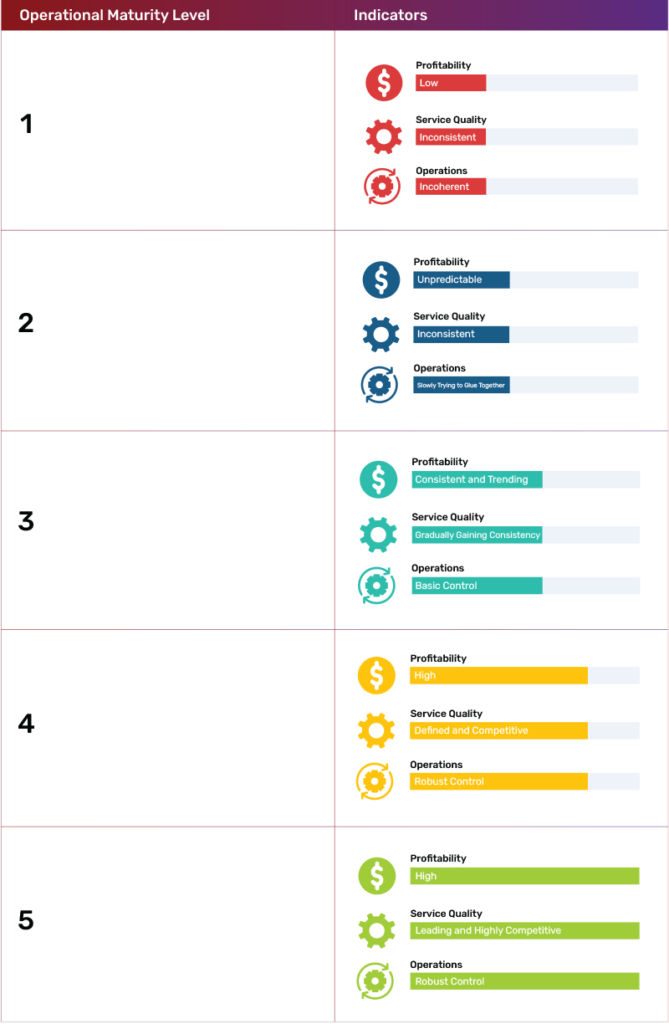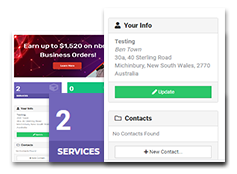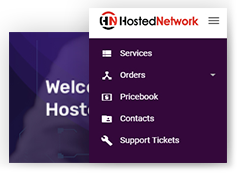Have you ever wondered what stage your MSP is in? Yes, just like how butterflies go through metamorphosis, MSPs (like all businesses) reach different levels as they gradually progress in terms of profitability, service quality and overall operational performance.
In simpler terms, it is the evolution of MSPs.
The higher you climb the operational maturity ladder, the stronger your financial capability and the more consistent your organisation and processes will be.
Size doesn’t matter with operational maturity level. Some might think that the bigger your company size, the higher your level is. But in reality it has nothing to do with size. You can be at the top level with just 5 to 10 people and get stuck at level one or two with operations run by 150 staff.
Knowing your current level helps you be aware of the improvements you need to do to be able to increase your MSP’s business value.
So to give you an idea, here’s an overview of each operational maturity level:

Now that you know which level are you at, the next dilemma would be how can you get into the next stage? As great things don’t happen overnight, all transformations require the right nurturement.
Here are some of the essential areas your MSP should check to be able to reach the next level:
1. Price Increase Management
Cheap doesn’t always mean the best deal. The technology landscape is continuously evolving and service prices inevitably go with the flow. To handle pricing expectations easier, we recommend including this at the beginning of your conversation with your prospect customers. In this way, complaints and surprises (Well, in a bad way) could be avoided and you will be able to determine the customers who appreciate the value of technology, as well as your services.
Thriving MSPs work with clients who understand the importance of technology upgrades and the investment that goes with them.
Undercharging could affect the overall value of your offering as you might think of downgrading or removing an inclusion just to get a reasonable margin. Additionally, this can also reflect negatively on your smart customers if they start doubting the quality of your services.
If you can relate to the scenario above, here are more bad MSP habits that might ring a bell to you.
2. Selling Strategies
Another area to look into is how to increase profitability in driving business from new customers and as well as your existing pool of clients.
Pre-contract Assessments
One thing to check is your MSP pre-contract assessments. To be able to come up with a sound proposal, you should conduct a comprehensive technical evaluation of your clients’ current systems and infrastructure. As there are times that you need to do this on-site, this might require serious time and effort from some of your staff. Time and effort equate to cost. Now we go back to our notion that if your client sees the importance of the goal your MSP is trying to accomplish, they would likely be with you for the long ride.
Pre-contract assessments not only give you additional revenue but helps you filter out customers who are not aligned with your MSP’s objectives.
Cross-Selling and Upselling
Your MSP’s Monthly Recurring Revenue (MRR) is the key driver of your success. While onboarding new customers is a great way of building MRR, it isn’t always the easiest. Instead start with your low hanging fruit – your existing customers. You already have an existing relationship with them and you’ve established trust so it’s going to be significantly easier to get them to buy something additional vs a cold contact.
Start by building out a product matrix and mapping it back to each customer. Then review regularly to understand clearly which customers are your low hanging fruit.
If your customers are in contract with other vendors, open the conversation with them and if there is an interest circle back around closer to the contract end date. You should also add this as a deal in your CRM as a reminder. This will help build out your pipeline.
3. Vendor Management
Choosing the right vendor is critical for your MSP’s growth. If you always aim to provide the best solutions to your customers, the same goes with vendors to your MSP. Evaluate your vendor partners regularly and determine which ones not only provide consistent and reliable support but align with your company goals and can drive your MSPs operational maturity.
There are a lot of aspects that need to be taken care of for your MSP to keep growing. That’s why it’s essential to have vendors that you can lean on. Remember – their success depends on you so the reverse should also be true.
Choose partners that provide additional support in terms of sales and marketing, special training and are proactive enough to help you close your deals. You shouldn’t be the one chasing after them. You might haven’t noticed it yet, but your vendor could be the one who’s lagging you behind.
4. Technology Stack
While this might seem obvious as we all live in the ICT ecosystem, you can’t consider your MSP efficient if you don’t take your technology stack seriously.
Your MSP’s technology stack should be a pivotal piece in driving your MSPs Operational Maturity. A good stack should streamline the way you work and drive efficiencies within your business. For example – what good is an anti virus if it doesn’t have the ability to talk to your PSA or alert you to when there are issues?
Like with our point on vendor management, your technology stack should align with your MSPs objectives. The good news is that more and more technology is being focused towards MSP and the pain points they face.
Investing in your technology stack at the beginning of your journey can save you trouble as you move on to the higher stages of your operational maturity:
To fuel you up, you can start with the following essential software:
- Remote Monitoring Management (RMM) – Helps you in keeping track of your clients’ system remotely.
- What’s Popular: Atera, NinjaRMM, N-able, Barracuda, ManageEngine, Desktop Central
- Professional Services Automation (PSA) – Enables your MSP to have efficient processes in terms of client management, reporting, and billing
- What’s Popular: Autotask (Datto), Connectwise, Kasera, Accelo
- Customer Relationship Management – Used for keeping track of deals and organising sales pipeline
- What’s Popular: Hubspot, Salesforces, Monday.com, Pipedrive, Soho CRM
Wrap-Up
Progress happens when you finally decide to change the things that are holding you back from growing. They will often be a lot of small things so always be on the lookout for areas to improve.
You might not feel the results as quickly as you would like but the key to achieving your objectives is consistency. Remember nothing is ever going to be perfect, so don’t let “perfect” get in the way of “great”.
So sit down, reflect with your team and discuss your pain points and corresponding strategies on how you can overcome each one of them so you can finally move on to a higher stage of operational maturity.
Be sure to check out our MSP in Conversation series where we get MSPs of different sizes to talk about how they have overcome their challenges that were holding back their own operational maturity.
 Contact us
Contact us  Partner Login
Partner Login  Service Status
Service Status 


 August 04, 2021
August 04, 2021
 Madeleane Abejero
Madeleane Abejero
 4 mins
4 mins



